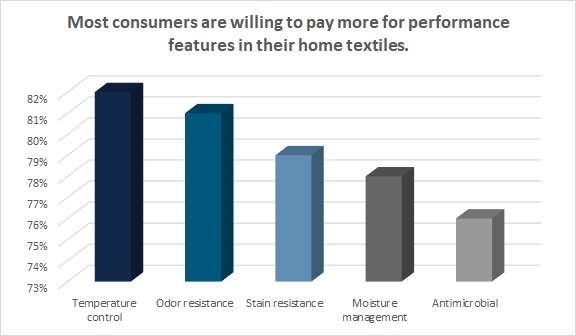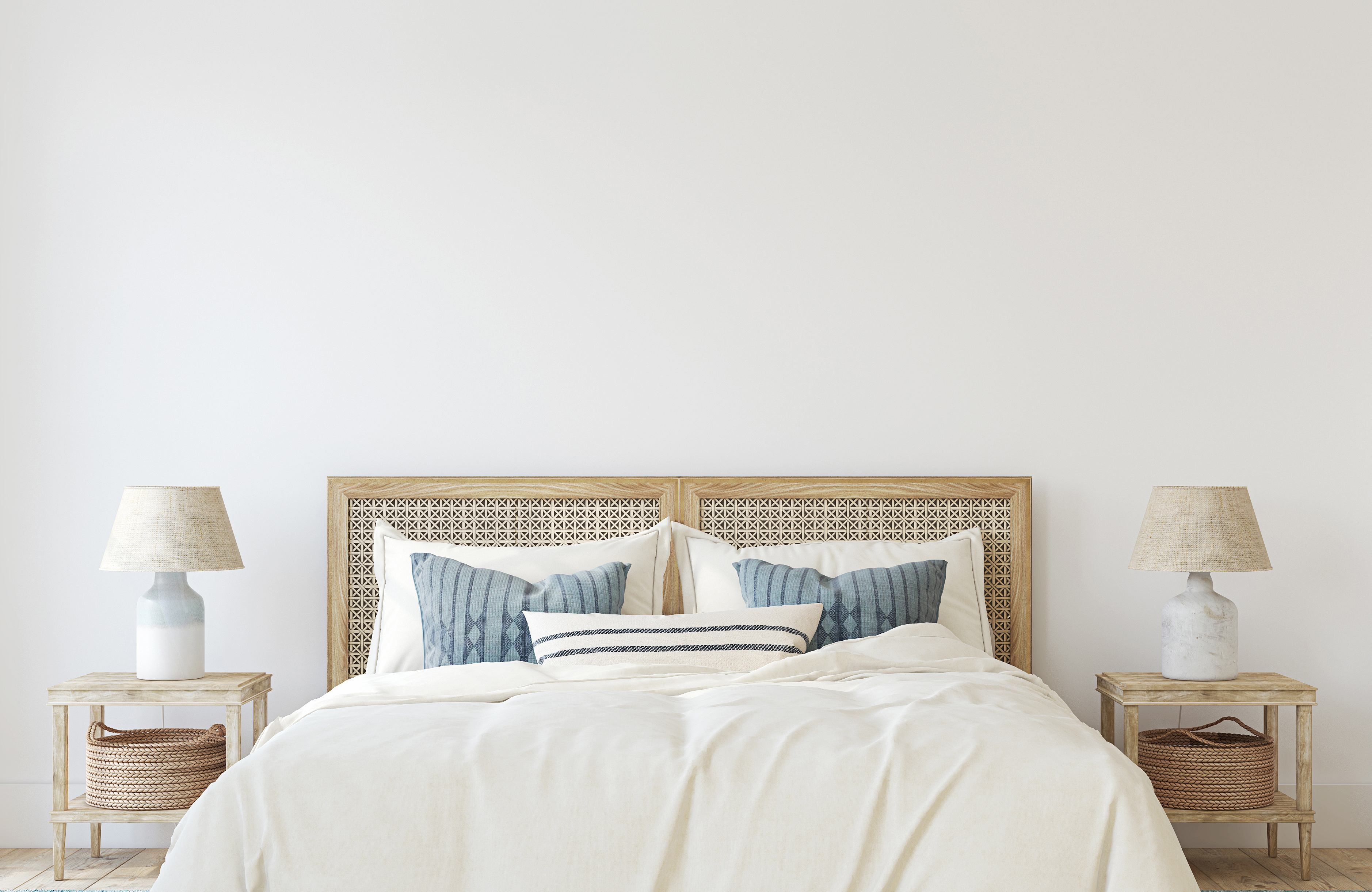If you want to know what’s trending in home textiles, take a look at some of the latest clothing fashions first. Think Coastal Grandmother, Tomato Girl Summer, as well as innovations in sustainability.
“Coastal trends have been huge lately in the home market (especially thanks to the resurgence of traditional motifs and the viral Coastal Grandmother/Tomato Girl Summer trends),” says Fashion Snoops’ Aurora Hinz, home and interiors strategist in an interview with the Lifestyle Monitor™.
Hinz says dye effects that mimic the ebb and flow of water, gauzy and lightweight materials, and patterns that speak to a strong sense of charming coastal nostalgia have been huge lately and do not show signs of going anywhere soon. Marine blues and greens, sunny yellows, soft neutrals, or gentle seashell-inspired colors are ideal for these coastal pieces.
People are seeking natural fabrics especially for bedding and bath, wanting these inherently intimate spaces to be as ‘clean’ as possible from harmful chemicals, microplastics, synthetic dyes, etc. Consumers are generally more aware of the importance of natural fibers for the planet and for their own personal health. This is really reflective of the pursuit of wellness and sustainability merging into part and parcel of one another.
Aurora Hinz, Home & Interiors Strategist, Fashion Snoops
Says Hinz, “We are expecting to see this trend continue and evolve with heightened concerns over the health of our oceans, the impacts of tourism, and an uptick in interest surrounding lifestyles that encourage a slower and more mindful approach to life.”
The global home textile market was valued at $125.6 billion in 2022 and is forecast to reach $174 billion by 2028, according to a report from ResearchAndMarkets.com.
Hinz says the indoor/outdoor pieces are also a continued focus for many brands. They’re using materials that are more durable, high-performance is encouraged and colorways need to speak to exterior and interior designs. She adds that colors and textures inspired by nature “will be paramount here — this also is a great fit for those coastal aesthetics. Sustainability is also a concern, as people want to be sure that these pieces are not shedding micro plastics or other pollutants in their yards or homes.”
In that vein, Wakefield Research’s Paul Bragan, senior partner at the global market research firm, says in a recent webinar that in general, consumers are looking for products that are durable, long-lasting, and fit their style, he says. But the specific purchase motivators are products that use sustainable materials, products from well-known brands and products with the latest innovations.
Cotton Incorporated’s newest technology, RESTech COTTON™, can help brands connect with consumers on the durability, sustainability, and innovation they’re seeking. This new technology, a new performance sheeting solution, blends cool comfort, exceptional durability and gentle softness — all while prioritizing sustainability. Initially tested for bed sheets, this versatile technology can also be used for a range of bedding products, including duvets and blankets.
RESTech COTTON™ technology takes the best attributes of cotton and cotton finishes to create a unique, durable product with non-fluorine technology, says Cotton Incorporated’s Hongqing (Mike) Shen, Ph.D., vice president and managing director of product development and implementation.
“It allows sheets to hold less moisture, dry more quickly and maintain remarkable softness and comfort,” Shen says. “This combination makes it a triple threat.”
Cotton Incorporated’s Jennifer Lukowiak, director, supply chain marketing, says RESTech COTTON™technology is a perfect choice for those seeking not just better sleep but a more sustainable one.
“We’ve captured the timeless comfort of cotton and enhanced it with modern innovation,” Lukowiak says. “It’s another proud milestone in our continuous effort to promote the natural excellence of cotton.”
This natural excellence makes cotton both appreciated and sought after by the majority of consumers, 70 percent of whom say they are likely to look for textiles described as being 100 percent cotton, according to Cotton Incorporated’s 2023 Home Textiles Survey.
Consumers are also looking for performance features in their home textiles and most consumers are willing to pay more for them, according to 2023 Home Textiles Survey. Theresearch shows 8 in 10 consumers are willing to pay more for temperature control (82 percent), odor resistance (81 percent), stain resistance (79 percent), moisture management (78 percent), and antimicrobial features (76 percent).

But again, sustainability and transparency are also resonating with today’s home textile consumers.
“Natural fibers are important and enhance a sense of comfort by creating peace of mind for consumers,” Hinz says. “People are seeking natural fabrics especially for bedding and bath, wanting these inherently intimate spaces to be as ‘clean’ as possible from harmful chemicals, microplastics, synthetic dyes, etc. Consumers are generally more aware of the importance of natural fibers for the planet and for their own personal health. This is really reflective of the pursuit of wellness and sustainability merging into part and parcel of one another.”
RESTech COTTON™ technology is considered to be a mindful choice for the environment, as its fiber content is crafted from 100 percent natural cotton fibers. It is also both biodegradable[1] and recyclable[2].
About 6 in 10 consumers say it is very important to know the fiber content of home textile products like sheets (66 percent), blankets (63 percent), bedding (60 percent), and towels (55 percent), according to the 2023 Home Textiles Survey.
Consumers say the main reason they want to know about fiber content – especially in towels (57 percent) and sheets (55 percent) – is it tells them about the quality of the products, according to the 2023 Home Textiles Survey. In sheeting, consumers say fiber content also helps them determine comfort (51 percent), how soft or fluffy the product feels (50 percent) and indicates the product’s ability to keep them warm or cool (45 percent). In toweling, shoppers say fiber content also determines how soft or fluffy the towel feels (57 percent), almost half (45 percent) say it makes a difference for comfort and 44 percent say it determines how well the piece will absorb moisture.
Clearly, quality is important to consumers. And in sheets and bedding, fully 87 percent say quality sheets and bedding can help them sleep better, according to the 2023 Homes Textiles Survey.
The new RESTech COTTON™ technology is meant to improve on the natural quality offered by cotton. RESTech COTTON™ technology offers cooling comfort for hot sleepers, meaning it has an enhanced moisture management property, drying up to 50 percent faster than rayon on the skin[3].
RESTech COTTON™ technology also offers a gentle touch that is up to 40 percent softer than untreated cotton sheets[4], turning bedtime into a luxurious experience. Further, it is naturally hypoallergenic, making it suitable for those with skin sensitivities. And since RESTech COTTON™ technology is crafted from natural fibers, there are no plastics or petroleum-based fibers contributing to microplastic pollution.
Such technology taps into the current interests in both sustainability and wellness. An article for the imm Cologne, the international furniture and interiors fair, said sustainability, wellness and individuality have been shaping society “for some time” and will continue to impact the interior design industry.
Per Hinz, today’s consumers are concerned with sleep health and hygiene as part of their daily wellness rituals.
“Textiles with cooling fibers or properties and weighted blankets to help with insomnia are examples of how this market is catering to these arising needs,” Hinz says. She adds that natural fibers in bed and bath products also add an extra layer of comfort as well as a peace of mind that the products used in their most intimate spaces are not harmful to themselves or to the planet.
“We are seeing experimentation in the way these fibers are used, especially in the worlds of fleece or fuzzy blankets which have been made from mostly synthetic materials like acrylic or polyester in the past,” Hinz says. “Kids’ bedding is also more and more concerned with using sustainable and natural fibers. As children outgrow their pieces, it’s important to parents that the remaining products do not live on as ‘forever plastics.’”
Wakefield’s Bragan also points out that where loyalty is concerned, most consumers (66 percent) – especially young families – are faithful to the products, materials or brands with which they’re already familiar.
“In this space, there is a strong sense of loyalty — meaning consumers want to stay close to what they know and have used before,” Bragan says. “It’s the latest innovations and the latest product developments that are a strong driver, meaning consumers are looking for new product benefits and features, but they want them offered from brands and products they’ve used before.”
Bragan says it can be challenging to get these young consumers to try a new offering, but winning them over is very beneficial.
“More than three out of four consumers will tell others about the great experience they have had with that product or brand, and they will spread the word,” Bragan says. “You’re not just winning over one new consumer. You’re winning over someone who has the power to be a brand, product and feature advocate. And it’s a multiplier effect. It’s challenging but it yields dividends because they spread the word.”
[1] Zambrano MC, Pawlak JJ, Daystar J, Ankeny M, Venditti RA. Impact of dyes and finishes on the aquatic biodegradability of cotton textile fibers and microfibers released on laundering clothes : Correlations between enzyme adsorption and activity and biodegradation rates. Mar Pollut Bull [Internet]. 2021;165(January):112030. Available from: https://doi.org/10.1016/j.marpolbul.2021.112030
[2] Cotton products are recyclable only in a few communities that have appropriate recycling facilities.
[3] Water Retention (WR) Dry Time testing: Modified AATCC Test Method 199. 20HLTD on Sateen and Percale Sheeting.
[4] Internal Cotton Incorporated method using the Emtec TSA Softness Analyzer. 20HLTD on Sateen and Percale Sheeting.
